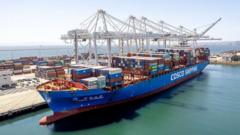The U.S. administration has formally announced its strategy to impose port fees on vessels originating from China, marking a significant step towards reinvigorating local shipbuilding and curbing China's maritime supremacy. This development was revealed by the U.S. Trade Representative (USTR), who clarified that the forthcoming fees would be less extreme than an earlier proposal from February, which considered charges as steep as $1.5 million for each Chinese ship entering American ports.
Set to take effect in 180 days, the port fees will incrementally rise over subsequent years. The USTR emphasizes that China's ascendancy in the shipping industry has positioned U.S. companies and workers at a competitive disadvantage. The fees imposed on Chinese vessels will be calculated using various metrics, including the weights of cargo or the number of containers and vehicles onboard.
Bulk carriers will incur a starting fee of $50 per ton of cargo, which will subsequently increase by $30 per ton annually for the next three years. Container ships will begin with an $18 per ton fee, or $120 per container, again escalating in the coming years. Additionally, non-U.S. built ships transporting automobiles will face a charge of $150 per vehicle. Importantly, these fees will apply once for each voyage, capped at five times a year, and there are exemptions for empty vessels and specific domestic routes.
The USTR has outlined plans for further actions targeting U.S.-built ships that transport liquefied natural gas (LNG), set to roll out over the next two decades. This announcement arrives amid an already disrupted global trade landscape, with many cargoes intended for the U.S. rerouted to European ports due to ongoing tariff disputes, as highlighted by trade experts.
The implementation of these tariffs could elevate prices for American consumers and has already motivated a noted increase in Chinese imports into the UK and EU, prompting industry concerns about rising costs. Experts suggest that the disruption in shipping routes and logistics, compounded by strikes in major European ports, poses a fiercer challenge for international trade, with evident congestion seen in Felixstowe, Rotterdam, and Barcelona.
Business leaders are predicting a need for companies to reevaluate and potentially overhaul their supply chains due to these tariff changes. As pressures mount on shipping practices, the ultimate impact of these measures on global trade and consumer markets remains to be seen.
Set to take effect in 180 days, the port fees will incrementally rise over subsequent years. The USTR emphasizes that China's ascendancy in the shipping industry has positioned U.S. companies and workers at a competitive disadvantage. The fees imposed on Chinese vessels will be calculated using various metrics, including the weights of cargo or the number of containers and vehicles onboard.
Bulk carriers will incur a starting fee of $50 per ton of cargo, which will subsequently increase by $30 per ton annually for the next three years. Container ships will begin with an $18 per ton fee, or $120 per container, again escalating in the coming years. Additionally, non-U.S. built ships transporting automobiles will face a charge of $150 per vehicle. Importantly, these fees will apply once for each voyage, capped at five times a year, and there are exemptions for empty vessels and specific domestic routes.
The USTR has outlined plans for further actions targeting U.S.-built ships that transport liquefied natural gas (LNG), set to roll out over the next two decades. This announcement arrives amid an already disrupted global trade landscape, with many cargoes intended for the U.S. rerouted to European ports due to ongoing tariff disputes, as highlighted by trade experts.
The implementation of these tariffs could elevate prices for American consumers and has already motivated a noted increase in Chinese imports into the UK and EU, prompting industry concerns about rising costs. Experts suggest that the disruption in shipping routes and logistics, compounded by strikes in major European ports, poses a fiercer challenge for international trade, with evident congestion seen in Felixstowe, Rotterdam, and Barcelona.
Business leaders are predicting a need for companies to reevaluate and potentially overhaul their supply chains due to these tariff changes. As pressures mount on shipping practices, the ultimate impact of these measures on global trade and consumer markets remains to be seen.





















